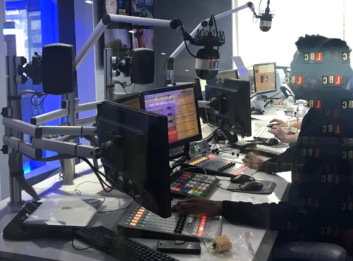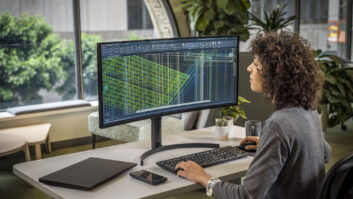The author is owner of Kline Consulting Group LLC.
It’s time to build that new studio (or upgrade an existing one) and everyone on the team is excited. Whether you are constructing a brand new facility or simply renovating it, there are common considerations to keep in mind to ensure you are satisfied with the end result.
 1. What’s ideal? From the outset of designing your new studio you need to ask what the meaning of “ideal” is. After all, there are many opinions on what the ideal studio looks like. Ask your colleagues, program directors, managers and do some online research. Chances are you will get a lot of feedback with varying responses. Write all of them down and prioritize what’s important.
1. What’s ideal? From the outset of designing your new studio you need to ask what the meaning of “ideal” is. After all, there are many opinions on what the ideal studio looks like. Ask your colleagues, program directors, managers and do some online research. Chances are you will get a lot of feedback with varying responses. Write all of them down and prioritize what’s important.
This list will likely get filtered and organized based on your budget, timeline and resources. The important takeaway here is that you first think about what is ideal and then define it. Not in a vacuum, but with the meaningful input of your end-users, stakeholders, engineers, and thorough research. Be creative. Be different. But don’t forget an ideal studio should always include good engineering practice.
2. Organization and structure. Put a project management team in place from the onset. Your project may be just one small studio, or it may be a building full of content-generating technology. It may be limited in scope and budget or it may be very large with many moving parts. Regardless of the project extent, you should have a clearly defined decision-making structure in place.
This will help with prioritization and refinement of the myriad of design requirements that you will encounter. When you have several passionate individuals on a design team it takes leadership and structure to make balanced decisions. Studios rarely get built without outside help. Contractors and system integrators may occasionally need assistance navigating a problem or unexpected hiccup. The project leader should be empowered to coordinate and delegate as necessary to deal with such an event.
Good structure also helps to avoid budget issues and schedule delays. As the lead engineer and/or project manager, make sure you are in on the design phase early so you can incorporate critical requirements into the drawings. I’ve seen too many studio designs that were “backed into” because things such as HVAC, MEP, the lobby, the kitchen, or the office space had been designed (perhaps commissioned) before important broadcast technical design considerations were integrated.
[Read “How to Choose Your Next Radio Console”]
I’ve also seen leases signed before the technical design team was consulted. Roof rights (and access), satellite dish placement, telecom availability, floor load capacity, microwave path, generator availability and restrictive landlord regulations are just some of the critical issues a person who is not experienced in broadcast technical requirements may overlook.
3. Reflect on user experience and user interface. Build a modern, impressive and user-friendly studio. Examine every inch of the space you are designing very closely. Carefully consider every decision you make about the location and placement of objects in each individual room. Start with the furniture layout as this is crucial.

Furniture design can improve the quality of the on-air content because the layout and look sets the mood (and interaction) in the room. Invest in the nicest looking and well-constructed studio furniture your budget will allow. Things such as video monitor placement, mic arm style and height, lighting, ergonomics, line-of-sight, windows, workspace, control surfaces, table and chair height and room size/layout will have an impact on the user (and guest) experience. Also, consider consolidating different software systems (playout, editing, contesting, call screening, social media, etc.) into one or two screens. This eliminates the wall of monitors many studios have. It also allows for a better and more efficient user interface, while improving line of sight to the other talent or guests in the room. There are different opinions about what constitutes a good interface and experience for the user. Some people want lots of buttons and flashy lights. Some take a minimalist approach with very little “tech” in the room. Some studios incorporate glass screens for the mixing desk, bypassing the traditional tactile faders and knobs often used. Some people want to sit down, some want stand up and some studios have motorized adjustable furniture height, etc.
Design your UI/UX so that it makes the most sense for your needs. This may require considerable research, time and a team effort to produce a good plan. Organize meetings and interviews with the end users and listen to them. Their input is valuable, as they will use the studio every day. Additionally, your architect, interior designer, studio furniture vendor and even Google can help you with creative ideas.
4. Acoustics. Stellar room acoustics probably has more to do with the quality of how the announcer or live performance sounds than the fancy electronics you just purchased. Do not underestimate the significance of this. In most radio studio environments, you don’t want a “live” sounding room because that will take away from the intimacy and intelligibility of the air talent.
We’ve all heard the hollow or echo effect in a poorly built studio when one or more mics are open. Instituting proper isolation so that there is no sound leakage outward and no external noise inward is imperative. There are ways to quantify isolation such using an STC rating. There are different STC ratings for materials such as sound panels, doors, windows, and external walls. Budget and design requirements will dictate your choice for a minimum STC rating. Each room has its own set of design criteria. Take a newsroom for example. That space may not require isolation, hoping that the inherent background room noise adds additional credibility over the air.
This topic is too large to cover everything here. Just keep in mind that acoustical design involves specialized construction techniques and materials, something your architect, interior designer, or acoustical consulting engineer can help you with. If you don’t have the budget to hire a consultant, there are many acoustic design examples online in addition to books and articles. Reach out to your engineering buddies or a mentor and ask them for advice.
5. Future growth and expansion. It helps to group this subject into categories: Physical growth inside the existing space, growth into an external location, technology upgrades of existing infrastructure, and expansion into new technologies. As you think about the future, here are just a few things to deliberate. Will you need additional studios later? How many? To serve what purpose? Is a particular studio that you are constructing firmly dedicated to a purpose that could change later? Did you leave enough expansion space for additional studios, offices, technology, or a surprise request?
Can you add new studios, streams, metadata, storage, and production capability, etc. quickly and cost-effectively? Did you box yourself in with a tech platform that won’t scale as you grow? Did you choose an audio protocol that is too proprietary?
Did the business office review your key suppliers’ finances to ensure they will be in business long-term? Have you studied broadcast technology trends to understand what the world might look like in three to five years? Does your physical plant and technology platform lend itself toward those future trends? Again, these are just a few things to think about. So remember to consider the future and its potential impact on what you are building today.
6. Speaking of technology. What technology will you use? Is there an organized approach to defining and selecting the technologies, which will be the cornerstone of your build out? Almost everyone builds his or her new radio studio using a digital platform. Which AoIP platform and protocol(s) will you use? Is it compatible with other popular formats and equipment?
If your facility will be producing video such as visual radio, branded content, or podcasts, have you carefully researched what equipment is needed to do that? Do you understand the special requirements that a podcast creator might need as it relates to technology? Do you have a visual radio strategy and technical plan? (see Radio World ebook Trends in visual Radio 2019.
Do you have a media asset management system in your plans? Will you index your audio, so it is searchable? Metadata for audio content is a hot topic these days. Will your metadata content look consistent across HD Radio, DAB, and most importantly, hybrid radio/connected car?
Did you include the digital team in these discussions? Will you build a large legacy TOC (rack room) or will you make use of the cloud where possible? Have you considered using virtualization to aggregate and manage things such as console engines, audio processing, streaming, codecs, transmission, and many other functions?
Have you researched the latest trends in production software and workflow for audio and video? Are you building a live performance space? Does it incorporate the proper technology needed by musical acts? The list goes on but in short research as much as possible to ensure that you’ve made informed technology decisions in your design.
7. Social Media. Do you have a mediacentric IT fabric to support the specialized requirements of bandwidth-heavy digital audio and video? Is your facility optimized to communicate with your listeners given we live in the age of numerous voice and video apps and use them to engage with the audience? Can you put a Skype, Zoom, WhatsApp or mobile app on the air easily and reliably?
Do you support cellular HD voice calls? A simple POTS request line is no longer enough on its own to connect with the audience. Do you support real-time high-quality feeds to YouTube? FB Live? IGTV? Twitch? Do you plan to incorporate automatic speech-to-text intelligence so that some or all your content is searchable? Did you plan for a social media dashboard UI in the studio? You can track real-time audience sentiment using specialized software now — why not show that on that dashboard?
There are software and hardware products available to aggregate the relevant various social media platforms for broadcasters that are very powerful.
8. Security. Given the security breaches and ransomware attacks that have become reality, and considering how almost everything at the radio station connects to the internet, are you prepared? Do you have a security-aware culture in place? Your new studio and facility design should have an IT security framework, which would include redundancy, backups to the cloud, and a quick restoration plan. No studio design should ignore the potential for externally introduced malware. Do you have segregated networks and layers of security that surround them? Did you design each aspect of your studio and office technology with cybersecurity in mind? A simple firewall isn’t enough. Most experts agree it is not a matter of if, but when — so have a plan in place. (See Radio world ebook Cybersecurity and Studio Disaster Recovery.
9. Innovate. Don’t be afraid to innovate and think outside of the box. So many studios look similar — a desk, chairs, microphones, computer monitors, panels on the wall, fancy track lights, and a window. There is nothing wrong with that. However, some very modern facilities are being designed to look different from the typical studio layout. Avoid the typical console and chair cookie-cutter studio.
Design for the user experience and to enhance the on-air product. Design the workflow for the users so that it is easier and less time-consuming to do their job. Design a studio that can increase station revenue. Here’s an example of thinking outside the box: Do studios still need walls? There are examples of studios being built without walls nowadays or without physical consoles. There are also studios designed in the cloud, which allows for a less techy studio but more room for the talent. Sometimes, less is more.
10. Ask for help. It’s ok to ask for help. Every one of us has conferred with others to brainstorm or solve a problem at one point. Your architect, general contractor, electrician, mechanical engineer, and colleagues are there to help and share knowledge. Tour other stations.
Some of the best studios incorporate ideas from other creative designs. Dig into the thousands of photos online of cool radio and recording studios. Your studio furniture vendor has worked with many layouts across various projects. They will be another great resource for you and can, in many cases, share drawings and photos.
Build a well-thought out facility that achieves your team’s goals using all of the resources and expertise available to you.












